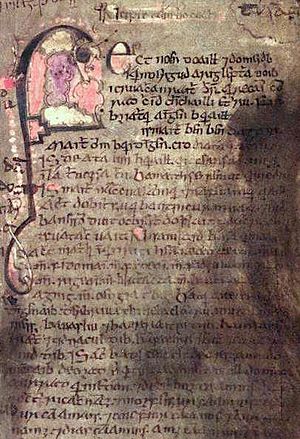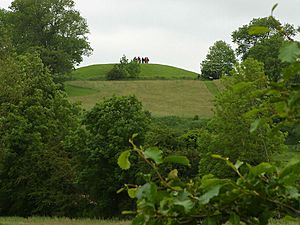The Tale of Mac Da Thó's Pig facts for kids
Quick facts for kids Scéla Muicce Meicc Da Thó |
|
|---|---|
| "The Tale of Mac Da Thó's Pig" | |
| Author(s) | Unknown Leinster author |
| Manuscript(s) | Book of Leinster (Trinity College, Dublin), H.3.18 (Trinity College, Dublin), Harley 5280 (British Library), Bodleian Library, MS Rawlinson B 512, MS. XXXVI (National Library of Scotland), H.6.8 (Trinity College, Dublin) |
| Genre | prose narrative of the Ulster Cycle and Cycles of the Kings; elements of self-parody |
| Subject | Provincial rivalry; heroic communal feasting |
| Setting | Mac Da Thó's Hostel, County Carlow, and surrounding Leinster countryside |
| Personages | protagonists: Mac Da Thó, king of Leinster; Cet mac Mágach; Conall Cernach; Conchobar, king of Ulster; Fer Loga, charioteer of Ailill |
The Tale of Mac Da Thó's Pig (in Old Irish: Scéla Muicce Meicc Da Thó) is a famous old story from Ireland. It's part of a collection of legends called the Ulster Cycle.
This tale is about a big argument between two powerful groups: the Connachta (led by Ailill and Medb) and the Ulaid (led by Conchobar mac Nessa). They are fighting over who gets to own a special dog named Ailbe, who belongs to Mac Da Thó, the king of Leinster.
To solve the problem, Mac Da Thó decides to host a huge feast. But things get even more complicated when a fight breaks out over who gets the curadmír, or "champion's portion," of a giant pig. This story was written around 800 AD by an unknown author from Leinster. It's a great example of early Irish literature and was very popular long ago.
Contents
Where We Find This Story

This ancient story has been kept safe in six different old books, called manuscripts. These books were written between the 1100s and the 1700s.
The oldest and most important versions of the story are found in three of these books:
- The Book of Leinster, written around 1160 AD.
- H.3.18, kept at Trinity College, Dublin.
- Harley MS. 5280, found at the British Library.
These old texts help us understand the original story. Scholars like Rudolf Thurneysen have studied them to put together the best version of the tale.
How the Story Was Made
The Tale of Mac Da Thó's Pig was likely written around 800 AD. The person who wrote it is unknown, but they probably lived in Leinster, a region in Ireland. This is because the story knows a lot about the places in modern County Kildare.
The different versions of the story found in old manuscripts are similar but not exactly the same. This suggests they all came from an even older, lost version of the tale. Some later versions of the story, like the one in Bodleian Library, MS Rawlinson B 512, changed parts of the tale. These changes sometimes made the story smoother but also added new details or even misunderstandings.
Long ago, this story was also known as Orgain Mic Da Thó ("The Slaughter of Mac Da Thó"). It was even mentioned in old poems and lists of important stories that professional storytellers would tell to kings.
Meet the Characters
Mac Da Thó
Mac Da Thó is the main host in the story. He is described as the king or a very important hosteller (someone who runs a guesthouse) of Leinster. Some old poems suggest his real name might have been Mes Róidia. He was known for being a bit quiet or keeping secrets, which might be why he was called "Mac Dathó" (which could mean "son of two silent persons").
Mac Da Thó had a wife named Maine Athrai and a son named Lena.
The Famous Hound: Ailbe
The story begins with Mac Da Thó owning a very special hound named Ailbe. This dog was so famous that it protected all of Leinster. Kings and queens from other parts of Ireland, like Ailill and Medb from Connacht and Conchobar mac Nessa from Ulster, all wanted to own Ailbe.
Messengers from Connacht offered Mac Da Thó a huge payment: 160 milk cows, a chariot, and two excellent horses right away, plus the same amount again next year. The messengers from Ulster offered "jewellery and cattle and everything else from the north," promising a great friendship.
Mac Da Thó, after talking to his wife, came up with a clever plan. He decided to promise the dog to both groups. He figured they would have to fight it out themselves!
The Big Feast and the Champion's Portion
Both groups, the Connachta and the Ulaid, arrived at Mac Da Thó's hostel on the same day, expecting to get the dog.
For the feast, Mac Da Thó had a giant pig slaughtered. This pig had been fed 60 milk cows for seven years and was so huge that 40 oxen could fit on it! The pig immediately caught everyone's attention.
The big problem was how to divide the pig. Who would get the curadmír, the special "hero's portion"? It was decided that the warriors would boast about their past brave deeds in battle. The one who could prove they were the greatest champion would get to carve the pig.
Cet Mac Mágach's Boasts
Cet mac Mágach, a warrior from Connacht, stepped forward first. He claimed the right to carve the pig, saying no one in Ireland could match his feats. He challenged anyone to prove him wrong.
One Ulster warrior, Lóegaire, tried to object. But Cet quickly reminded him of a time Cet had wounded him with a spear, forcing Lóegaire to retreat. Lóegaire had to sit down in shame.
Cet continued to out-boast several other Ulster warriors, including Óengus, Éogan, Muinremur, and Mend. He even shamed Celtchar mac Uthechar and Conchobar's son, Cúscraid Mend Macha, by recalling how he had wounded them in battle. Each time, the Ulster warriors had to sit down, defeated by Cet's words.
Conall Cernach Arrives
Just as Cet was celebrating his victory, the great Ulster hero Conall Cernach walked into the hostel. The Ulaid cheered loudly. Cet and Conall exchanged some old, formal verses, and Cet admitted that Conall was a better warrior than him. However, Cet added that his brother, Anlúan, would have beaten Conall. Conall then said it was a shame Anlúan wasn't there, and threw Anlúan's head, which he had with him, at Cet!
In shame, Cet left the pig to Conall. Conall then claimed the belly of the pig for himself, which was enough food for nine men! This left only the fore-trotters (front legs) for the Connachta.
The Fight and the Chase

The Connachta were furious with their tiny share. They rose up against the Ulaid, and a huge fight broke out inside the hostel and then spilled outside into the courtyard. One warrior, Fergus, even ripped a huge oak tree out of the ground!
Mac Da Thó then let Ailbe, his famous hound, loose to see which side the dog would choose. Ailbe sided with the Ulaid, and this helped the Ulaid win the fight, chasing the Connachta away.
As the Connachta were fleeing westward, a charioteer named Fer Loga hid in the bushes. As Conchobar's chariot passed, Fer Loga jumped in and grabbed the king's head from behind. Conchobar promised him anything he wanted to let him go. Fer Loga asked to be taken to Emain Macha, the capital of Ulster. There, he wanted the women and young daughters of Ulster to sing to him every evening, saying, "Fer Loga is my darling."
A year later, at the end of the story, Fer Loga rode westward from Ulster, taking two of Conchobar's horses with golden bridles.
What the Story Means
The Tale of Mac Da Thó's Pig is considered one of the best early Irish stories. It shows us what heroic life was like in ancient Ireland, full of warriors and battles.
The Champion's Portion
A main idea in the story is the curadmír, the right of the greatest champion at a feast to get the "hero's portion" of food. To claim this, warriors would boast about their brave deeds and try to make their opponents look bad. This was a common tradition in ancient Celtic societies. Old Greek writers even described similar feasts among the Gauls (Celts) where the best warriors got the best food and would boast about their courage.
Rivalry and Humor
Another important theme is the rivalry between the powerful regions of Connacht and Ulster. The story shows this rivalry through the contest between Cet Mac Mágach and Conall Cernach.
Interestingly, the author of this story was from Leinster, and they seem to make fun of both Connacht and Ulster. Mac Da Thó, the king of Leinster, outsmarts both of them. This suggests that the story might have been written to show that Leinster was cleverer than the other regions. However, it's also clear that the author used these political rivalries just to tell a really good and funny story.
One unusual thing about this tale is that it features many characters from another famous Ulster Cycle story, Táin Bó Cuailnge, but it never mentions Cú Chulainn, who is usually the main hero. This might mean that this story is even older than some of the tales about Cú Chulainn. The exaggerated size of the pig and the fight over a dog instead of a great bull also suggest that the story might be a bit of a parody, making fun of the heroic stories of the time.

